MX" + BX' + KX = F(t). (4) so we will also do as much work as we can without specifying the forcing term F(t); that allows our work to be applicable in either case. Exercise 1: Write Equation 4 as a first order system of equations, find the eigenvalues of the homogeneous system (that is, when F(t)= 0), and find the solution to that system. We will find it useful to define the parameter B 20=√√ You should assume that ſo 2M
MX" + BX' + KX = F(t). (4) so we will also do as much work as we can without specifying the forcing term F(t); that allows our work to be applicable in either case. Exercise 1: Write Equation 4 as a first order system of equations, find the eigenvalues of the homogeneous system (that is, when F(t)= 0), and find the solution to that system. We will find it useful to define the parameter B 20=√√ You should assume that ſo 2M
Advanced Engineering Mathematics
10th Edition
ISBN:9780470458365
Author:Erwin Kreyszig
Publisher:Erwin Kreyszig
Chapter2: Second-order Linear Odes
Section: Chapter Questions
Problem 1RQ
Related questions
Question
Please show all work! Do exercise 1 please.
![**Transcription for Educational Website:**
Both equations (2) and (3) are in the general form:
\[ MX'' + BX' + KX = F(t), \]
so we will also do as much work as we can without specifying the forcing term \( F(t) \); that allows our work to be applicable in either case.
**Exercise 1:** Write Equation 4 as a first order system of equations, find the eigenvalues of the homogeneous system (that is, when \( F(t) = 0 \)), and find the solution to that system. We will find it useful to define the parameter
\[ \Omega_0 = \sqrt{\frac{K}{M}}. \]
You should assume that \( \Omega_0 > \frac{B}{2M}. \)](/v2/_next/image?url=https%3A%2F%2Fcontent.bartleby.com%2Fqna-images%2Fquestion%2F5ea01508-f9b6-4a19-b038-56e12c298daf%2F3cd41ef1-b6a2-4318-8f2d-fbb8a4f67290%2F0j2s5db_processed.png&w=3840&q=75)
Transcribed Image Text:**Transcription for Educational Website:**
Both equations (2) and (3) are in the general form:
\[ MX'' + BX' + KX = F(t), \]
so we will also do as much work as we can without specifying the forcing term \( F(t) \); that allows our work to be applicable in either case.
**Exercise 1:** Write Equation 4 as a first order system of equations, find the eigenvalues of the homogeneous system (that is, when \( F(t) = 0 \)), and find the solution to that system. We will find it useful to define the parameter
\[ \Omega_0 = \sqrt{\frac{K}{M}}. \]
You should assume that \( \Omega_0 > \frac{B}{2M}. \)
Expert Solution
Step 1: Solution

Step by step
Solved in 3 steps with 2 images

Recommended textbooks for you

Advanced Engineering Mathematics
Advanced Math
ISBN:
9780470458365
Author:
Erwin Kreyszig
Publisher:
Wiley, John & Sons, Incorporated

Numerical Methods for Engineers
Advanced Math
ISBN:
9780073397924
Author:
Steven C. Chapra Dr., Raymond P. Canale
Publisher:
McGraw-Hill Education

Introductory Mathematics for Engineering Applicat…
Advanced Math
ISBN:
9781118141809
Author:
Nathan Klingbeil
Publisher:
WILEY

Advanced Engineering Mathematics
Advanced Math
ISBN:
9780470458365
Author:
Erwin Kreyszig
Publisher:
Wiley, John & Sons, Incorporated

Numerical Methods for Engineers
Advanced Math
ISBN:
9780073397924
Author:
Steven C. Chapra Dr., Raymond P. Canale
Publisher:
McGraw-Hill Education

Introductory Mathematics for Engineering Applicat…
Advanced Math
ISBN:
9781118141809
Author:
Nathan Klingbeil
Publisher:
WILEY

Mathematics For Machine Technology
Advanced Math
ISBN:
9781337798310
Author:
Peterson, John.
Publisher:
Cengage Learning,

